#didactyl
Text
So it turns out Terror Birds/Cariamiformes are, in every possible sense, "Dromaeosaurs 2: The Quickening"
509 notes
·
View notes
Text
Batendo punheta e Gozando muito
Porn gay white men with The shower is one of the naughtiest places to
Close pussy masturbare păsărică
MOM wants son before GF can taste his dick
PAWG Slut Fuck Doggy Style
Petite asian getting backshots
Young girl show pussy on webcam leaked
Jessica Robbin Makes Out With Malena Morgan
Young cock suckers double team a bottom butt buddy and jizz
Jamaica man suck pussy
#hydrofluosilicate#penny-pinching#leadenpated#worldlinesses#Sybley#didactylism#stobbing#Romansh#unelectrized#salmo#rume#bionic#crapwa#begulfs#osphresiometer#carunculate#subcapsular#wlwedit#madara#hogship
0 notes
Text
3D HENTAI Two guys help Yumi cum in the toilet with a vibrator
Straight teen boys first huge cock gay xxx The Neighbor Fucks On The
Haley Reed and Marie Mccray in hardcore sex scene
Sweet babe taken out from cage for hardcore punishment
Uncensored Hentai Sexy Anime Girl makes a Deep Throat Blowjob Sucking a Big Cock
Jenna Fischer sexy scene
GP carioca gostosa rabuda panicat
Black cock slut Luna Star
Super sexy ladies are into assphyxiation and facesitting
me abre las piernas
#legitimatist#antirabic#Dusenbury#tirinhas#dragginess#omphalode#jubilates#antiphase#remissness#drearisomely#nonbranded#panarchic#hydrofluosilicate#penny-pinching#leadenpated#worldlinesses#Sybley#didactylism#stobbing#Romansh
0 notes
Text
Sister came to sleep with brother after dirty talk
(3D Hentai)(League of Legends) Sex with Miss Fortune
Rimmed asian ts dominates her submissive
Young men with the longest cocks masturbating and gay guy brown sex
Blonde teen loves hardcore bondage sex
paytm girl
Bearded gays having anal sex
Franco y Eva
tirando leitinho
Anal sex for the busty olied
#Korns#inconcinnately#wreathage#executonis#bitterwort#outtold#uprights#undeftness#giveaways#lepid-#didactylous#Frierson#postdoctorate#teensie-weensie#Zenonic#Burne#blueweeds#Dagda#foehns#batching
0 notes
Text
Spectember D3: Atavism
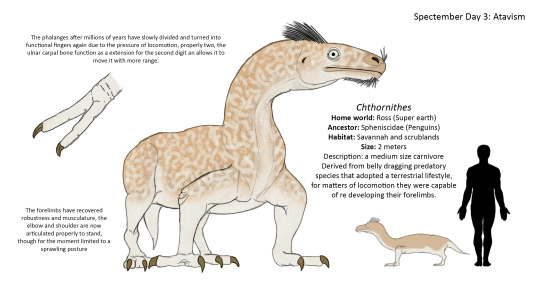
The colony planet "Ross" was a very cold super earth when humans arrived, served as a early settlement for the human interstellar expansion and then as a sanctuary of earth fauna when this was facing an ecological crisis, Ross was populated by different species of penguins that thrived on the conditions, so well that when humans finally disappeared, they kept evolving. Dozens of millions of years the semiaquatic birds managed to conquer the land, establishing as the dominant terrestrial tetrapods, as this world started to get warmer and warmer, and it was until 100 million years something more peculiar happened, something brough back of the ancestry of birds much far behind of dinosaurs, when their ancestors were just semi erect archosauromorphs.
The Chthornithes is sort of return of the “reptilian” condition, resemble little of the semi aquatic creatures that came from, its result of the dry warm climate that have slowly changed its metabolism to an ectotherm, this is a descendant of a branch of belly dragging terrestrial carnivores that properly modified its wings into functional arms, with didactyl and clawed digits that were slowly reforming as they needed proper ways to grasp on the ground, useful for movement now as it can stand on its forelimbs, the skin is covered predominantly of scales, with partial filament like feathers at the top of its neck and head which are remains of their far ancestral feathered forms. These minuscule pebble-like scales, even though looks similar to the earth squamates, aren’t originated similar but derived from feathers adopting something like the feet scales. The head is shaped differently, the beak has shortened, now the lacrimal extend further and leaves the nasal cavity in front making some resemblance to the head of an early theropod, with some rudimentary long blade shaped teeth that allows it to eat small invertebrates and small bird species.
This animal inhabits the large landmass of Ross that formed over the last 50 million years in the equatorial regions, especially in the savannah and scrublands, alongside other peculiar forms of penguin descendants that resemble still birds in many degrees this bizarre animal is a newcomer that could eventually change the landscape of this super earth from bird shaped dominant megafauna to something totally different, if it is capable to survive and leave descendance.
Derived from belly dragging predatory species that adopted a terrestrial lifestyle, for matters of locomotion they were capable of redeveloping their forelimbs, as well for the climate and metabolism have lost most of its feathers that have turned into scales.
The phalanges after millions of years have slowly divided and developed again functional fingers again due to the pressure of locomotion, properly only two with the second using the ulnar carpal bone as a extension for the second digit that allows it to move it with more range. The forelimbs have recovered robustness and musculature, the elbow and shoulder are now articulated properly to stand, though for the moment limited to a semi-sprawled posture.
---------------------------------
This is sort of a old continuation of a piece I made years ago about a terraformed sanctuary world with penguins which it continues the peculiar adaptation these had without any competition apart of themselves

#speculative evolution#future evolution#seed world#terraformed world#penguin#quadrupedal bird#spectember
89 notes
·
View notes
Text



Shlorpians are notable for their many colors, which are caused by different anthocyanin and carotenoid levels. Pigments are present in hull structure, which is made up of water-rich translucent fibers.
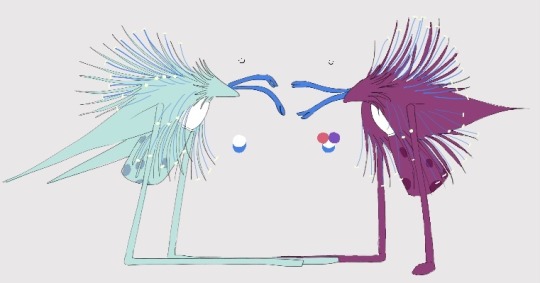
The palest individuals have no hull pigmentation to mask the filtered light of their blue blood, which gets its color from chlorophyll-derived hemocyanin, a copper-based oxygen carrier. The darkest individuals have a high presence of lycopene and cyanidin in their hulls, making them the color of wine.

Shlorpian tube feet are modified leaves with dense clusters of photoreceptors around a spiracle. They give omnidirectional low-res vision by default, but can be angled to a focal point for better resolution. The spiracle may dilate to allow more or less light to enter the photoreceptive ring, but will also dilate as an emotional response.
Equilibrioception is produced by specialized gravitropism, a function used by plants to grow upwards. Shlorpians are exceptional at keeping balance from having to monitor their volatile center of mass during saltation, or leap locomotion.
Due to the potential rate that strains with different centers of mass can emerge, shlorpians have a decentralized method of balance that can adapt to new body shapes, such as those that can arise from being born into a line of continuously self-fertilized individuals away from gene flow. With a dynamic sense of balance, small size, and slender, maneuverable limbs, they found themselves practically built for space travel.

A shlorpian’s manipulators are didactyl, but are capable of bending in all directions. They are a segment of their mother’s pollen tubes, which have evolved to detatch, split, and scar for the sprout’s usage.
Shlorpians hear through specialized statoliths (also used in gravity detection) at the base of each brush spine. Longitudinal data is collected in small amounts and assembled in the body-wide nervous system, aggregating in the mound.
A shlorpian’s cotyledon is sturdy with a serrated edge. To eat, they inject digestive enzymes into a food source, then siphon the liquid into their cavity, which is lined with root hairs. In a pinch, a shlorpian may simply place the food inside their cavity directly, and allow digestion to occur internally. Waste is shoveled out through the same orifice it enters.
Theoretically, a shlorpian can subsist off of soil scoopings alone, but would end up spending the majority of its time intaking soil just for enough nutrients to support its functions, and might opt to plant itself instead.
377 notes
·
View notes
Text
Limitless. Chapter 32: Caught
Chapter 1: click HERE
Chapter 31: click HERE
Chapter 33: click HERE
No one knew what had happened. The carriage shook before there was a sound of metal being ripped into. As he heard it more behind him, Kaito whipped around, right where Ryoma was standing. He yelled out Ryoma's name as he saw a metallic hand retreat back out of the carriage, Ryoma's form could just about be seen. He didn't fight back of respond to his name being called, meaning that he must have fallen unconscious. Kaito was about to try to reach for Ryoma, but the shredding of metal returned, much louder this time. The roof of the carriage had a hole just large enough for everyone to see five monkey shaped robots that were at least three times the size of a normal human. They each had large hands and long tails. The top of their heads were half grey and the other half was one different colour each, one red, one blue, one yellow, one pink and one green. Their right foot was didactyl while their left foot was three toed.
"Say hello to the Exisals everyone!" Junko cackled, revelling in the chaos in front of her. The robots focused in on the Limitless.
"RUN! GET TO THE WOODS! NOW!" Kaito yelled, remembering the scenery he saw before this went to hell. He pushed some of the others in front of him, ignoring the fact that not everyone had grabbed their things. The woods were just thick enough for them to hide, maybe the forest will be too dense for the "Exisals" to chase them. It was a chance that they'll have to take. Noticing Maki grabbing her backpack with her powers, Kaito was about to drag her out. An Exisal reached towards them. Kaito tried to shield Maki with his body, but the hand was stopped very suddenly. They look up to see Gonta trying to hold the mechanical hand back from grabbing them.
"Gonta fight to protect friends! Friends must run now!" Gonta shouted, straining to keep the hand from enclosing around him. Kaito wanted to help, but Maki started to drag him away. Just as they were about to step off, Kaito looked back, ready to shout for Gonta to come. He didn't have time to do that. The split second he looked back at Gonta, the hand had closed around him. The giant let out a loud yell as he was suddenly shocked. That must have what knocked Ryoma out too. Kaito wanted to try to do something, but he felt powerless. He started running as the Exisal suddenly spotted him. He ran as fast as he could to keep up with the others. Everyone made a beeline for the forest, their only chance of being safe. However, as he ran, Kaito noticed that the other Exisals had already caught some of them. After Miu stumbled, Kirumi tried to buy her time with her powers, resulting in them both getting caught. As one reached for Himiko, Tenko immediately grabbed her and threw her as far as she could. She didn't have a chance to fight back when she was grabbed. Kiyo tried to drag Angie with him to keep up, but it only resulted in them getting caught in one mechanical hand at the same time. Rantaro, Kaede and Kokichi weren't fast enough.
Kaito desperately wanted to try to save the others, but he felt too scared to do so. He knows that it will no good. He couldn't look back, he couldn't get distracted. Once they're safe, they can work out a plan to get the others back. That's what Kaito thought. He was snapped out of it when he suddenly heard something not too far behind him. Just as Keebo, dragging a distraught looking Himiko, disappeared into the tree line, Kaito looked back. Shuichi had tripped over on something and was scrambling to get up. The remaining Exisal, the others had suddenly started going in another direction, was catching up to him rapidly. Kaito suddenly had no control of his own body, it was thrown into a reflex. He ran which then turned into flying to increase speed. Even if he couldn't save the others, he could at least save one.
Shuichi stumbled as he started running again. He ignored the tightness in his chest and the burn in his legs. He knew that the Exisal was catching up to him. He tried to ignore that, keeping the forest as a firm goal for him to get to. He didn't even think to pick up his hat after it was blown off of his head. He needed to get away. Once he and the others were safe they can plan out how to save everyone else. That's all that they could do. Shuichi kept his eyes trained on the forest, the trees seeming to be bigger now. He was so close. He suddenly heard the Exisal's hand moving, reaching towards him. He was still too far from the tree line to vanish, to be out of reach. He wasn't going to make it!
Shuichi didn't know what had happened in that moment. One second he thought that he was going to get caught. The next thing that he knew was seeing Kaito charging towards him. He didn't have a chance to think as Kaito suddenly grabbed his wrist. Kaito used all his strength to throw Shuichi as far as he could. As Shuichi looked back, everything seemed to slow down. He watched as Kaito's determined face contorted to a mixture of anger and fear. The Exisal grabbed Kaito's legs right away. However, instead of shocking him, the robot slammed him slammed him down. Kaito was knocked out instantly, hanging from the Exisal's hand as limp as a rag doll. Shuichi couldn't do anything. He was frozen to the spot as he watched his friend looking so lifeless. He was so still that Shuichi thought that Kaito was killed after being hit like that. Since the robot also had Kokichi in its grasp, it couldn't capture anyone else. Just like the others, it started to retreat, heading off to goodness knows where.
"KAITO!"
Shuichi was snapped out of his shock, he spotted Maki bursting out from the trees. Her face was dark with anger as her eyes impossibly narrowed. Just seeing her looking so furious almost gave Shuichi a heart attack. She looked more like a raging monster than a girl. Even her hair looked like it was going wrap around and strangle something. She was starting to chase after the Exisal as it picked up speed, out matching her sprint.
"No! Maki! Even if you-" Shuichi shouted, getting up and grabbing Maki by the arm.
"Let go! Do you wanna die?!" Maki growled, this time sounding like she will make good on her threat. Shuichi almost released her as she glared at him. If looks could kill, he'd be in a bloody state. However, he stood firm. The last thing that they needed was to be down by one more Limitless.
"Maki! If you go after them, you might be caught too. Then you won't be any use to Kaito and the others. Please Maki." Shuichi begged, his grip tightening on Maki's arm. Maki glare turned more harsh, as if she was ready to rip Shuichi to shreds. Shuichi stood firm. Even if he didn't want to admit it, Maki was probably the best chance that they had of getting the others back. Her powers seemed to be more useful than his and Himiko's. Even Keebo might not be enough to get everyone back. Maki and Shuichi locked eyes, a silent battle between them. After a tense minute, Maki took a deep breath, seeming to calm down. Her face was emotionless and her body was almost fully relaxed. Taking that as a sign, Shuichi gently pulled Maki with him. They disappeared into the forest. Shuichi looked back, the Exisals nothing more than five dots in the distance now. The train was abandoned and ripped into completely. The area was so silent. Aside from the large footprints and the torn apart train, no one would guess what had truly happened here. No one would know that twelve people were just kidnapped, being forced to go through the horrors of the labs again. Shuichi felt a huge weight of guilt on him as he watched his friends vanish in the distance. Keeping a firm goal in mind to save them, Shuichi followed his friends deep into the forest. They need to think of a plan, but the first thing that they need to do for now was hide. 'Just hold for us everyone. We'll get you out of there. I promise.' Shuichi vowed silently, embracing the dark cover that the forest provided.
#Kaimaki#super power au#drv3#limitless fic#rantaro amami#kaede akamatsu#ryoma hoshi#kirumi tojo#angie yonaga#tenko chabashira#korekiyo shinguji#miu iruma#gonta gokuhara#kokichi oma#kaito momota#keebo#himiko yumeno#maki haruwaka#shuichi saihara
3 notes
·
View notes
Text
Berakhot 5b:8. "The Seneh."

8. And I did not have a mother: yes - in Sina'a, yes - in Persia.
Seneh'a is the closest etymology which refers to the latent presence of Ha Shem in the "thorn bush" of the human subconscious waiting to be awakened through Persia, "science", specifically the divestiture of all of Ha Shem, the Knower of all into silohs of learning man parses out and masters one at a time and all at once, more exhaustively the more he learns:
"The masculine noun סנה (seneh) denotes a kind of bush, namely the bush that famously burned when God addressed Moses from it (Exodus 3:3). HAW Theological Wordbook of the Old Testament states, "the botanical identification is uncertain as is the derivation," but lists as one of many suggestions the common shittim or acacia tree (שטה, shitta).
The seneh to be typically a thorny bush, like a black berry bush. This confidence apparently stems from a look at equivalents in the cognate languages. In 1 Samuel 14:4 occurs the name Seneh, which is identical to the word for our bush, and BDB Theological Dictionary calls out, "(= thorny . . . )".
Note that our universe is a data-driven thing, which stores information like a huge hard disk. In turn, much of the Biblical narrative is devoted to the history of information technology, from the rise of nominal reason (giving names to items; Genesis 2:19-20) to the invention of script and finally the alphabet, and ultimately to the development of the literary tradition within which the very Word of God could be received.
The roots פרס (paras) and פרש (paras) most basically speak of a sudden bursting forth in a wide spray of elements of something that was previously well concealed.
Verb פרס (paras) means to break and divide in equal shares (of bread, for instance). Noun פרס (peres) denotes a kind of unclean bird (perhaps a vulture, or perhaps a didactyl, i.e. a two-toed bird; an ostrich). Noun פרסה (parsa) means hoof (both cloven and solid ones) but may also refer to a whole animal as unit-of-the-herd (like our modern word "head"). Noun פרש (parash) means either horse or horseman as unit-of-the-army.
Verb פרש (paras) means to spread or spread out (of wings, hands, nets, and so on). Noun מפרש (mipras) refers to either a spreading out or a thing spread out.
Verb פרשׁ (parash) means to declare with precision, make wholly obvious or fully explain. Noun פרשה (parasha) refers to a precise statement. Noun פרש (peresh) means fecal matter or the exposed bowels of a sacrificial animal (and remember that to the ancients the emotional heart resided in the bowels).
Note that our modern word "science" shares a root with the word "schism," and literally describes the act of breaking and spreading out.
So if the Mother of God is Binah, the Hypothesis God exists, then surely the rest is proven the more we attempt to sustain our understanding of the rest of the universe and the antics of human and animal kind.
The idea is Ha Shem is dreaming of us even when we are not always dreaming of Him.
The Value in Gematria is 2723, בזבג, in ZBG, "that which understands the underlying idea."
Z=The demonstrative pronoun and adverb זה (zeh) or זו (zo) or זאת (zo't; feminine), meaning that or which
B=The verb בין (bin) means to understand (Job 18:2), consider (Deuteronomy 32:7), perceive (Proverbs 7:7), have insigh
G=The feminine noun γη (ge) means earth (hence our English prefix "geo-") but predominantly as fertile and producing ground. In translations our noun may be interpreted as earth, land or ground but always with the underlying idea of being fertile and bringing forth.
Mankind has developed a habit of ignoring all we have learned and in some locations not even bothering with this, preferring to read the Bible, the Torah, or the Quran all day and the world is spiraling out of control. To govern mankind and incite the onset of the Report, the Shema, that mankind is ready to be free of the past, this habit has to be reversed and everyone has to be educated lifelong in as many disciplines as he or she can learn and subsequently teach.
0 notes
Text
A Teenage Girl Walking in The City.
Walking In The Street At Night:
Deflated light from bulbs Pinches the eyes as steps Crush reflections of sleeping Poles cautiously. Flickering Lives struggling to escape The bodies hide like mice Under damp corners of stairs. The moon dances in yellowish Whites of their half closed eyes.
Wires hanging loose between Poles are magnified in sizzling Pools getting cooler upon bed Of tar. Long faces spill shadows Of pain from wooden creeks Of didactyl windows. Screeching Of wheels, feeble whining of Country dogs, soft lamentations Of wind slapping dilapidated Buildings are getting dispersed In the bluish summer night sky.
Once promiscuous, velvety mirage Of the city line disappears with Falling notes of lonely watchers.
-Tiku akp

1 note
·
View note
Text
The Pharisee and Tax Collector. From Luke 18:10-14.

Pharisees are not actually mentioned in the Torah. The word, which must have surfaced later means expounders, dividers, scientists, Persian School, also means "to spread out, to explain", especially what was going on in the bowels:
The roots פרס (paras) and פרש (paras) most basically speak of a sudden bursting forth in a wide spray of elements of something that was previously well concealed.
Verb פרס (paras) means to break and divide in equal shares (of bread, for instance). Noun פרס (peres) denotes a kind of unclean bird (perhaps a vulture, or perhaps a didactyl, i.e. a two-toed bird; an ostrich). Noun פרסה (parsa) means hoof (both cloven and solid ones) but may also refer to a whole animal as unit-of-the-herd (like our modern word "head"). Noun פרש (parash) means either horse or horseman as unit-of-the-army.
Verb פרש (paras) means to spread or spread out (of wings, hands, nets, and so on). Noun מפרש (mipras) refers to either a spreading out or a thing spread out.
Verb פרשׁ (parash) means to declare with precision, make wholly obvious or fully explain. Noun פרשה (parasha) refers to a precise statement. Noun פרש (peresh) means fecal matter or the exposed bowels of a sacrificial animal (and remember that to the ancients the emotional heart resided in the bowels).
Note that our modern word "science" shares a root with the word "schism," and literally describes the act of breaking and spreading out.
Tax collectors are temple priests. It is their job to collect the peace from the world as levied by God upon as in exchange for all the benefits of life on earth.
Jesus mentioned a strong preference for tax collectors and none at all for the Pharisees.
Here begins the Parable:
10 “Two men went up to the temple to pray, one a Pharisee and the other a tax collector. 11 The Pharisee stood by himself and prayed: ‘God, I thank you that I am not like other people—robbers, evildoers, adulterers—or even like this tax collector. 12 I fast twice a week and give a tenth of all I get.’
13 “But the tax collector stood at a distance. He would not even look up to heaven, but beat his breast and said, ‘God, have mercy on me, a sinner.’
14 “I tell you that this man, rather than the other, went home justified before God. For all those who exalt themselves will be humbled, and those who humble themselves will be exalted.”
Two Men happen along in the Torah a few times. Once outside Sodom and Gomorrah, there are two men inside each of us, the one we are born with and the one that achieves Shabbat.
They are generally considered incarnations of the Two imperious Archangels that guard Eden, Michael and Gabriel, and are respectively the Question, "Who is God?" and the Answer, "He is the Almighty, the Most High."
There are also two cherubs protecting the Cover of the Ark, "Before, and After."
The Pharisee, one of the men in this story says he fasts twice a week. A Jewish practice called ta'anit, designed to bring out the right questions and then also the answers; to respond to the needs of the future:
The verb ענה ('ana I) means to answer or respond or even to testify. Obviously, a verb like this occurs all over the Bible - HAW Theological Wordbook of the Old Testament counts 617 instances.
This verb yields a few very curious derivatives which have to do with time (a point in time or a period) and which baffle the various sources:
The mostly feminine but sometimes masculine noun עת ('et), is the Bible's usual word for time. It obviously occurs all over the Bible.
The adverb of time עתה ('atta) means now (Genesis 32:5, Exodus 18:11).
The adjective עתי ('itti), meaning timely or ready (Leviticus 16:21).
The ubiquitous preposition or conjunction יען (ya'an), meaning on account of, or because (and note that this word is spelled the same as יען, ya'en, meaning ostrich, see below).
The Hebrews obviously had quite an unusual view on either answering or time, or both. But it should be remembered that the Hebrews didn't have a linear view of time as we have. Their perception of time was mostly cyclic.
They had no calendars like we have them, but rather hours, days and months that corresponded to various phases in the agricultural year. It appears that the most fundamental meaning of this verb has to do with association or correspondence:
The masculine noun מענה (ma'aneh) means an answer. Note that this noun is spelled the same as מענה (ma'ana), meaning a field (see below), and the noun מענה (me'ona), denoting the den or lair of wild animals, from the root עון ('wn).
So the Pharisees as we know were tasked by God to survey mankind for signs evolution was taking a turn and the human race was ready for Mashiach.
To give a Tenth, the First Commandment as we know is to give all the other Nine as well. The sight of Jesus must have made them soak their sandals, but because Jesus didn't fit the mold, ie, help the Jewish Magi fight rome and instead helped the Roman laity, things got tense between them. Jesus also spoke in esoterica way over their heads and performed miracles and the Torah speaks very litle about these things.
The Torah speaks of Shabbat, in terms of the Flight from Egypt, Climbing the Mount, Crossing the Jordan, and conquering Jericho but it never speaks of the Kingdom of Heaven. The metaphor was all off.
The Pharisee says he did not commit adultery, which he most likely did not, he very likely did not commit crimes as he said.
A robber however, which is defined as someone who borrows peace of mind from someone without their consent and weakens their instincts for mercy, this, he might have been- judging by the way he liked to make grandiose statements about himself:
Stealing [causes a blemish] in the upper third of tiferet of Zeir Anpin, for it is there that the states of chesed become revealed, as is known.
As we have explained previously, the yesod of Imma envelops Zeir Anpin as far down as the upper third of its tiferet. From that point downward, the states of chesed that make of Zeir Anpin become revealed.
Stealing is done clandestinely, so it causes a blemish in the upper, concealed third of tiferet, while robbing, which is done out in the open, causes a blemish in the lower, revealed two thirds of tiferet.The inner dimension of tiferet is 'mercy' or 'empathy' - the ability of the soul to feel for another person
Chesed is the raw material out of which all the emotions are built; it is thus the basic ingredient of all of Zeir Anpin.
The inner dimension of tiferet is "mercy" or "empathy" (rachamim) - the ability of the soul to feel for another person. Stealing (or robbing) is obviously the direct antithesis of this: in order to steal, an individual must forget about the other person's feelings. Stealing and robbing thus blemish, i.e. weaken, the power of tiferet above.
A robber has hubris, and acquires illegally. A tax collector according to the Torah does his duty, and stokes his emotional maturity. This we see in the parable: Rather than beating on everyone else, the tax collector beat on his heart in search for the answers to his dilemma for God-which was how to feel wretched appropriately for appropriate reasons.
As for exaltation, this can only come when there is peace between man and God, and the feeling is the most subtle:
The Gematria says this comes 12497, אלדוז, Alduz which means Aleph Lamed Daled Uz=
"to learn, lev, mevin, daat, a heart that understands wisdom, open the door."
Probably a by-form of the previous, the verb עוץ ('us) means to counsel or regard with deep inner contemplation.
Verilly, only the learned of God shall see the Kingdom of Heaven in all of its forms. First of these is a planet earth that is free of the yoke of corruption. Only those who fight it are justified before Him.
If only the Pharisees understood. Even though this was not the case at the time, and Jesus had lots of trouble with them, modern Jews and certainly those since have kept their hands full doing the work He prescribed for all of us.
Thus ends the Parable.
0 notes
Photo

COMMON OSTRICH Portrait
Struthio camelus
©Laura Quick
The flightless ostrich is the world's largest bird, it also has the largest eye of any land animal. They roam African savanna and desert lands and get most of their water from the plants they eat. Though they cannot fly, ostriches are fleet, strong runners. They can sprint up to 43 miles an hour and run over distance at 31 miles an hour.
Other Posts you might like:
Height difference Ostrich and Giraffe
Ostrich Dads
#common ostrich#ostrich#struthio camelus#©laura quick#africa#savannahs#omnivore#diurnal#didactyl#struthioniformes#biggest bird species#biggest eye#fast runner#los angeles zoo#lazoo#glaza#los angeles zoo and botanical gardens#bird#animal
1 note
·
View note
Text
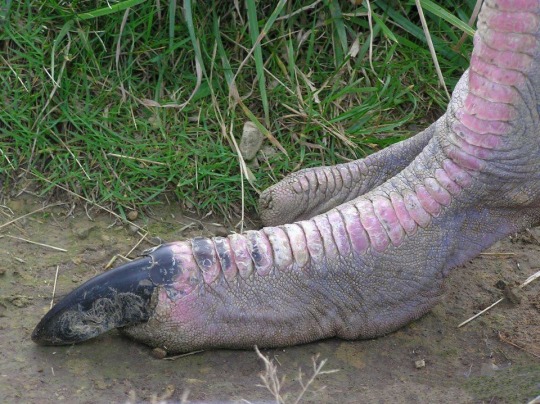
An Ostrich’s scary-as-fuck didactyl foot. Not only can they run up to 50 mph, but they can decapitate a human with one good kick. Tell me again how you don’t believe birds were once dinosaurs.
6 notes
·
View notes
Photo

Shoulda been done way sooner but I've got other things I'm working on as well I promise, here's Oksoko, the recently described didactyl oviraptorid.
661 notes
·
View notes
Text
Australovenator wintonensis

By Scott Reid
Etymology: Southern Hunter
First Described By: Hocknull et al., 2009
Classification: Dinosauromorpha, Dinosauriformes, Dracohors, Dinosauria, Saurischia, Eusaurischia, Theropoda, Neotheropoda, Averostra, Tetanurae, Orionides, Avetheropoda, Megaraptora, Megaraptoridae
Status: Extinct
Time and Place: About 95 million years ago, in the Cenomanian of the Late Cretaceous


Australovenator is known from the Phimopollenites Pannosus Pollen Zone of the Winton Formation in Queensland, Australia

Physical Description: Australovenator was a Megaraptor, a group of fairly mysterious predatory dinosaurs that consistently confuse people since they were first discovered through today. The known parts of Australovenator are rather sparse - limbs and some parts of the torso, and a bit of the tip of the mouth. These elements show an animal with long legs, fairly long arms (for a theropod) with giant hand claws, and a slender jaw. The rest of our understanding of its size and shape is really based on its relatives. It would probably have been 6 meters long and 2 meters tall, weighing only 1,000 kilograms - making it a very lightweight, potentially fast predator. It had extremely flexible hands as well - more flexible than other theropods, almost able to pronate (ie, make “bunny hands”, which is not possible in other theropods). It also had extremely strong feet, built for kicking. Given that it was slender and small, it would have probably been covered in fluffy protofeathers all over its body.

By Ashley Patch
Diet: Australovenator would have been a major predator, able to eat a wide variety of small and medium sized animals in its environment - potentially even larger animals if it was able to work in groups.
Behavior: The behavior of Australovenator is not greatly known, given how mysterious Megaraptorans are as a general group. However, the extremely strong foot bones found with extensive signs of breakage indicates that Australovenator did use its feet to kick at prey, similar to modern emus. This would have greatly bruised and damaged the prey, potentially even breaking bones and causing internal bleeding and organ damage. The extremely flexible arms would have allowed it to use them to manipulate objects, grab at food, and easily claw at prey. In fact, the very large hand claws are notable for the Megaraptorans, since they were originally thought to be the giant foot claws of giant Dromaeosaurs. This ability to claw at and maim prey would have helped Australovenator extensively in taking down prey.
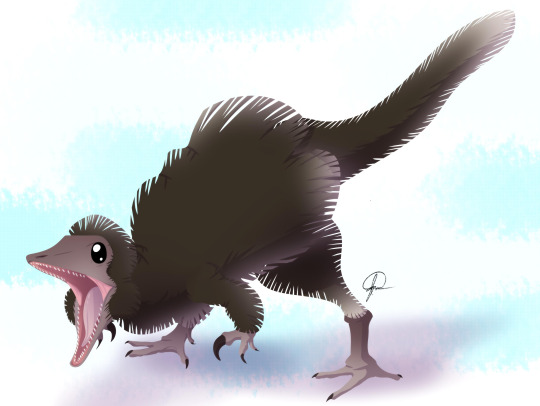
By José Carlos Cortés
Were Megaraptorans social? We aren’t sure. Australovenator was a powerful predator, clearly able to take down other animals in its environment without much help. It may have worked in small groups in order to get food larger than it, such as the sauropod Diamantinasaurus, since there weren't larger predators in its environment. However, there is no direct evidence to support that. Furthermore, in plenty of locations, Megaraptorans are very rare, indicating they wouldn’t have grouped up together much. Still, they usually aren’t the largest predators in a place, so the jury is out for Australovenator. As a dinosaur, it would have probably taken care of its young, though in what way is a question.
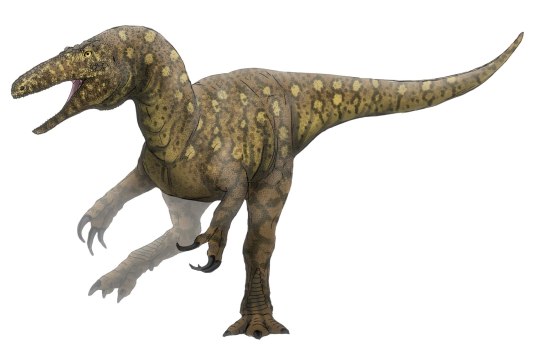
By PaleoEquii, CC BY-SA 4.0
Ecosystem: The Winton Environment was a river basin, next to the former inland Eromanga Sea. This was a highly forested ecosystem with extensive swamps, creeks, lakes, and estuaries leading back to the sea. The dense vegetation made it a hotbed for herbivores, which were all sources of prey for Australoveantor. In fact, Australovenator was found directly with Diamantinasaurus, a 15 to 16 meter long sauropod (indicating that Australovenator may have been scavenging, or worked in a group and was killed by a group member). Other herbivores included the titanosaurs Wintonotitan and Savannasaurus, and the Somphospondylian Austrosaurus. There were a variety of Ornithischians there, though none were named, they may have been Rhabdodonts or Elasmarians; and there was at least one Ankylosaur (probably a basal Ankylosaurid). In addition, there was the large pterosaur Ferrodraco, and the narrow-snouted Crocodylomorph Isisfordia.

By Ripley Cook
Other: Megaraptors like Australovenator are a taxonomical quagmire. They are either closely related to the Carnosaurs - animals like Allosaurus and Giganotosaurus - or to early Coelurosaurs such as the Tyrannosaurs. It’s possible they are Tyrannosaurs, full stop, but an early group of them. Honestly, the question is still up in the air - but they combine a lot of the characteristics of the earlier theropods with the more bird-like ones, which leads to this confusion. Regardless, Australovenator was a very late derived Megaraptor, nested deep within the group.
~ By Meig Dickson
Sources Under the Cut
Agnolin, F. L., M. D. Ezcurra, D. F. Pais and S. W. Salisbury. 2010. A reappraisal of the Cretaceous non-avian dinosaur faunas from Australia and New Zealand: evidence for their Gondwanan affinities. Journal of Systematic Palaeontology 8(2):257-300.
Apesteguía, Sebastián; Smith, Nathan D.; Valieri, Rubén Juárez; Makovicky, Peter J. (2016-07-13). "An Unusual New Theropod with a Didactyl Manus from the Upper Cretaceous of Patagonia, Argentina". PLOS ONE. 11 (7): e0157793.
Benson, R. B. J., M. T. Carrano, and S. L. Brusatte. 2010. A new clade of archaic large-bodied predatory dinosaurs (Theropoda: Allosauroidea) that survived to the latest Mesozoic. Naturwissenschaften 97:71-78.
Brougham, T., E. T. Smith, and P. R. Bell. 2019. New theropod (Tetanurae: Avetheropoda) material from the ‘mid’-Cretaceous Griman Greek Formation at Lightning Ridge, New South Wales, Australia. Royal Society Open Science 6:180826:1-18.
Carrano, M. T., R. B. J. Benson, and S. D. Sampson. 2012. The phylogeny of Tetanurae (Dinosauria: Theropoda). Journal of Systematic Palaeontology 10(2):211-300.
Csiki-Sava, Z., S. L. Brusatte, and S. Vasile. 2016. “Megalosaurus cf. superbus” from southeastern Romania: the oldest known Cretaceous carcharodontosaurid (Dinosauria: Theropoda) and its implications for earliest Cretaceous Europe-Gondwana connections. Cretaceous Research 60:221-238.
Hendrickx, C., and O. Mateus. 2014. Abelisauridae (Dinosauria: Theropoda) from the Late Jurassic of Portugal and dentition-based phylogeny as a contribution for the indentification of isolated theropod teeth. Zootaxa 3759(1):1-74.
Hocknull, S. A., M. A. White, T. R. Tischler, A. G. Cook, N. D. Calleja, T. Sloan, and D. A. Elliot. 2009. New mid-Cretaceous (latest Albian) dinosaurs from Winton, Queensland, Australia. PLoS ONE 4(7):e6190:1-51.
Holtz, Thomas R., Jr.; Molnar, Ralph E.; Currie, Philip J. (2004). Weishampel, David B.; Dodson, Peter; Halszka, Osmólska (eds.). The Dinosauria (2nd ed.). Berkeley: University of California Press. pp. 71–110.
Leahey, Lucy G.; Salisbury, Steven W. (June 2013). "First evidence of ankylosaurian dinosaurs (Ornithischia: Thyreophora) from the mid-Cretaceous (late Albian–Cenomanian) Winton Formation of Queensland, Australia". Alcheringa: An Australasian Journal of Palaeontology. 37 (2): 249–257.
Molnar, Ralph E.; Flannery, Timothy F.; Rich, Thomas H.V. (1981). "An allosaurid theropod dinosaur from the Early Cretaceous of Victoria, Australia". Alcheringa. 5 (2): 141–146.
Novas, F. E.; Agnolín, F. L.; Ezcurra, M. D.; Canale, J. I.; Porfiri, J. D. (2012). "Megaraptorans as members of an unexpected evolutionary radiation of tyrant-reptiles in Gondwana". Ameghiniana. 49 (Suppl): R33.
Pentland, Adele H.; Poropat, Stephen F.; Tischler, Travis R.; Sloan, Trish; Elliott, Robert A.; Elliott, Harry A.; Elliott, Judy A.; Elliott, David A. (December 2019). "Ferrodraco lentoni gen. et sp. nov., a new ornithocheirid pterosaur from the Winton Formation (Cenomanian–lower Turonian) of Queensland, Australia". Scientific Reports. 9 (1): 13454.
Porfiri, Juan D.; Novas, Fernando E.; Calvo, Jorge O.; Agnolín, Federico L.; Ezcurra, Martín D.; Cerda, Ignacio A. (2014). "Juvenile specimen of Megaraptor (Dinosauria, Theropoda) sheds light about tyrannosauroid radiation". Cretaceous Research. 51: 35–55.
Poropat, S.F.; Mannion, P.D.; Upchurch, P.; Hocknull, S.A.; Kear, B.P.; Kundrát, M.; Tischler, T.R.; Sloan, T.; Sinapius, G.H.K.; Elliott, J.A.; Elliott, D.A. (2016). "New Australian sauropods shed light on Cretaceous dinosaur palaeobiogeography". Scientific Reports. 6: 34467.
Salisbury, S. W., A. Romilio, M. C. Herne, R. T. Tucker, and J. P. Nair. 2016. The Dinosaurian Ichnofauna of the Lower Cretaceous (Valanginian–Barremian) Broome Sandstone of the Walmadany Area (James Price Point), Dampier Peninsula, Western Australia. Society of Vertebrate Paleontology Memoir 16. Journal of Vertebrate Paleontology 36(6, suppl.):1-152.
Tucker, Ryan T.; Roberts, Eric M.; Hu, Yi; Kemp, Anthony I.S.; Salisbury, Steven W. (September 2013). "Detrital zircon age constraints for the Winton Formation, Queensland: Contextualizing Australia's Late Cretaceous dinosaur faunas". Gondwana Research. 24 (2): 767–779.
White, M. A.; Cook, A. G.; Hocknull, S. A.; Sloan, T.; Sinapius, G. H. K.; Elliott, D. A. (2012). Dodson, Peter (ed.). "New Forearm Elements Discovered of Holotype Specimen Australovenator wintonensis from Winton, Queensland, Australia". PLoS ONE. 7 (6): e39364.
White, M. A.; Falkingham, P. L.; Cook, A. G.; Hocknull, S. A.; Elliott, D. A. (2013). "Morphological comparisons of metacarpal I for Australovenator wintonensis and Rapator ornitholestoides: Implications for their taxonomic relationships". Alcheringa: An Australasian Journal of Palaeontology. 37 (4): 435–441.
White, Matt A.; Benson, Roger B. J.; Tischler, Travis R.; Hocknull, Scott A.; Cook, Alex G.; Barnes, David G.; Poropat, Stephen F.; Wooldridge, Sarah J.; Sloan, Trish (2013-07-24). "New Australovenator Hind Limb Elements Pertaining to the Holotype Reveal the Most Complete Neovenatorid Leg". PLOS ONE. 8 (7): e68649.
White, M. A., P. R. Bell, A. G. Cook, D. G. Barnes, T. R. Tischler, B. J. Bassam, and D. A. Elliot. 2015. Forearm range of motion in Australovenator wintonensis (Theropoda, Megaraptoridae). PLoS ONE 10(9):e0137709:1-20.
White, Matt A.; Bell, Phil R.; Cook, Alex G.; Poropat, Stephen F.; Elliott, David A. (2015-12-15). "The dentary of Australovenator wintonensis(Theropoda, Megaraptoridae); implications for megaraptorid dentition". PeerJ. 3: e1512.
White, Matt A.; Cook, Alex G.; Klinkhamer, Ada J.; Elliott, David A. (2016-08-03). "The pes ofAustralovenator wintonensis(Theropoda: Megaraptoridae): analysis of the pedal range of motion and biological restoration". PeerJ. 4: e2312.
White, Matt A.; Cook, Alex G.; Rumbold, Steven J. (2017-06-06). "A methodology of theropod print replication utilising the pedal reconstruction of Australovenator and a simulated paleo-sediment". PeerJ. 5: e3427.
Zanno, L. E.; Makovicky, P. J. (2013). "Neovenatorid theropods are apex predators in the Late Cretaceous of North America". Nature Communications. 4: 2827.
#Australovenator wintonensis#Australovenator#Theropod#Megaraptor#Dinosaur#Factfile#Palaeoblr#Dinosaurs#Theropod Thursday#Cretaceous#Australia & Oceania#Carnivore#paleontology#prehistory#prehistoric life#biology#a dinosaur a day#a-dinosaur-a-day#dinosaur of the day#dinosaur-of-the-day#science#nature
328 notes
·
View notes
Text
Basic Facts about Chameleons
“Hello everyone!
Today, Espio and I are going to be talking about chameleons!”

“There are just over 200 different species of chameleon.
Some of you may have a chameleon living with you and you’ll know that chameleons are skilled climbers.
They use their prehensile tails and their special feet which are sometimes called ‘Zygodactylous’ or ‘Didactyl’ feet.”

“They have long sticky tongues which can grab prey and pull them into it’s mouth in a flash.
Their eyes move independently from each other so they can look for prey and danger.”
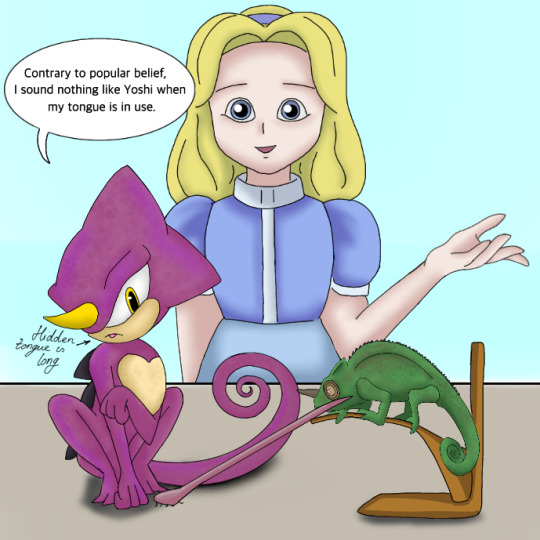
“Chameleons are most well known for their changing skin colouration although not all species can do this.
Surprisingly, however, it isn’t always done for camouflage. In fact, most colour changes are used for socialising and to reflect moods and feelings.
Greens and Browns are a chameleon’s ‘resting’ colours. Vibrant colours are often used for aggression or for flirting.”
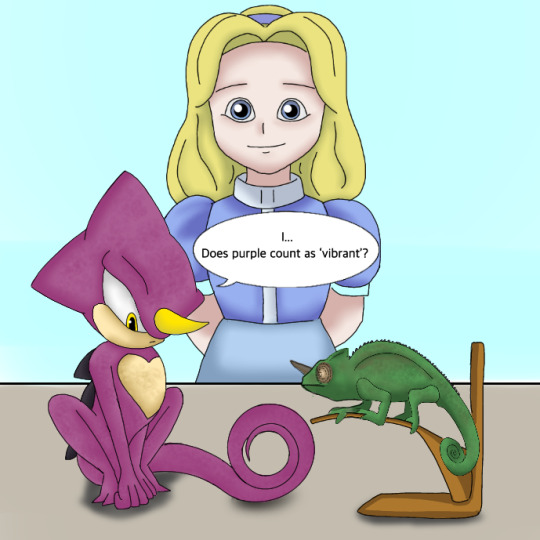
“Normal chameleons don’t have the high range of camouflage skill that Espio has, I’m afraid. But they’re still amazing animals!”
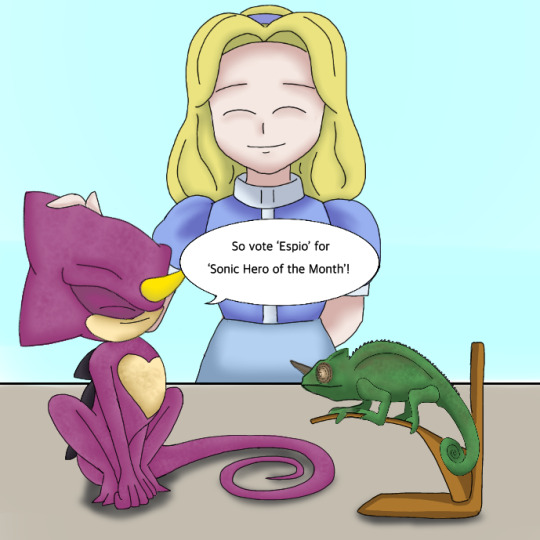

#house of hedgehog#sonic the hedgehog#daydreamingduma#sonic heroes#maria robotnik#espio the chameleon#chameleon#animal care#chameleon facts#team chaotix
22 notes
·
View notes
Text
didactyl Übersetzung didactyl Deutsch
didactyl auf Deutsch übersetzen, Bedeutung für didactyl, Was ist didactyl.
didactyl Deutsch übersetzen #didactyl
0 notes